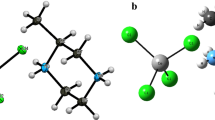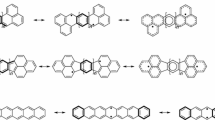Abstract
Electronic structures of four pyrene-derived N-heterocyclic carbene complexes of platinum(II) and gold(III) bearing cyclometallated 2,6-diphenylpyridine have been investigated theoretically. The structures of all complexes in gas phase have been first optimized. Different functionals and basis sets have been tested to find the best theoretical method. The results show that B3PW91 (LANL2DZ/6-31G*) combination give the best description of the molecules as compared with experimentally determined structural features. Using the calculation data from that best functional and mixed basis set combination, frontier molecular orbitals of the complexes have been examined. To gain understanding on the nature of electronic transitions in the UV-vis absorption spectra of the compounds, TD-DFT calculations have been carried out. A details analysis of the vertical excitation reveals that the nature of all the vertical electronic transitions in the complexes. Notably, the lowest energy transitions are πcb + dPt → \(\pi _{{{\text{cb}}}}^{{\text{*}}}\) (for Pt1 and Pt2) and πCNC → dAu + \(\pi _{{{\text{CNC}}}}^{{\text{*}}}\) (for Au1 and Au2) charge transfer in nature. A sharp contrast in lowest energy triplet excited state for d8‑squared planar Au1 and Pt1 has been demonstrated. While no contribution from gold(III) d orbital to the SOMO and SOMO – 1 orbital of Au1, there is significant contribution of platinum(II) dyz orbital in the SOMO – 1 orbital of Pt1, suggesting possible interaction of this singly occupied orbital with radical of π-symmetry substrates.








Similar content being viewed by others
REFERENCES
D. Bourissou, O. Guerret, F. P. Gabbaï, and G. Bertrand, Chem. Rev. 100, 39 (2000). https://doi.org/10.1021/cr940472u
N. Marion and S. P. Nolan, Acc. Chem. Res. 41, 1440 (2008). https://doi.org/10.1021/ar800020y
F. E. Hahn and M. C. Jahnke, Angew. Chem. Int. Ed. 47, 3122 (2008). https://doi.org/10.1002/anie.200703883
M. N. Hopkinson, C. Richter, M. Schedler, and F. Glorius, Nature 510, 485 (2014). https://doi.org/10.1038/nature13384
W. A. Herrmann, Angew. Chem. Int. Ed. 41, 1290 (2002). https://doi.org/10.1002/1521-3773(20020415)41:8<1290::aid-anie1290>3.0.co;2-y
S. Díez-González, N. Marion, and S. P. Nolan, Chem. Rev. 109, 3612 (2009). https://doi.org/10.1021/cr900074m
S. S. Shapovalov, O. G. Tikhonova, A. A. Pasynskii, et al., Russ. J. Coord. Chem. 44, 709 (2018). https://doi.org/10.1134/S1070328418120096
L. Cavallo, A. Correa, C. Costabile, and H. Jacobsen, J. Organomet. Chem. 690, 5407 (2005). https://doi.org/10.1016/j.jorganchem.2005.07.012
H. Clavier and S. P. Nolan, Chem. Comm. 46, 841 (2010). https://doi.org/10.1039/B922984A
K. Li, T. Zou, Y. Chen, et al., Chem. Eur. J. 21, 7441 (2015). https://doi.org/10.1002/chem.201406453
L. Oehninger, R. Rubbiani, and I. Ott, Dalton Trans. 42, 3269 (2013). https://doi.org/10.1039/C2DT32617E
W. Liu and R. Gust, Chem. Soc. Rev. 42, 755 (2013). https://doi.org/10.1039/C2CS35314H
Y. Liu, T. Harlang, S. E. Canton, et al. Chem Commun. 49, 6412 (2013). https://doi.org/10.1039/C3CC43833C
T. S. Vishkaee, R. Fazaeli, and M. Yousefi, Russ. J. Inorg. Chem. 64, 237 (2019). https://doi.org/10.1134/S0036023619020062
M. A. Baldo, M. E. Thompson, and S. R. Forrest, Nature 403, 750 (2000). https://doi.org/10.1038/35001541
M. S. Lowry and S. Bernhard, Chem. Eur. J. 12, 7970 (2006). https://doi.org/10.1002/chem.200600618
J. I. Goldsmith, W. R. Hudson, M. S. Lowry, et al., J. Am. Chem. Soc. 127, 7502 (2005). https://doi.org/10.1021/ja0427101
E. I. Mayo, K. Kilsa, T. Tirrell, et al., Photochem. Photobiol. Sci. 5, 871 (2006). https://doi.org/10.1039/b608430c
E. Baranoff, J. H. Yum, I. Jung, et al., Chem. Asian J. 5, 496 (2010). https://doi.org/10.1002/asia.200900429
D. Zhou, L. Lu, Y. Luo, et al., Russ. J. Coord. Chem. 44, 812 (2018). https://doi.org/10.1134/S1070328418120126
X. P. Zhang, D. S. Zhang, W. Sun, and Z. F. Shi, Russ. J. Coord. Chem, 44, 15 (2018). https://doi.org/10.1134/S1070328418010098
Yu. E. Begantsova, L. N. Bochkarev, E. V. Baranov, and V. A. Ilichev, Russ. J. Coord. Chem. 45, 856 (2019). https://doi.org/10.1134/S1070328419120029
A. A. Bilyalova, S. V. Tatarin, P. Kalle, et al., Russ. J. Inorg. Chem. 64, 207 (2019). https://doi.org/10.1134/S0036023619020037
W. Lu, B. X. Mi, M. C. W. Chan, et al., J. Am. Chem. Soc. 126, 4958 (2004). https://doi.org/10.1021/ja0317776
S. D. Cummings and R. Eisenberg, J. Am. Chem. Soc. 118, 1949 (1996). https://doi.org/10.1021/ja951345y
K. Li, G. S. Ming Tong, Q. Wan, et al., Chem. Sci. 7, 1653 (2016). https://doi.org/10.1039/C5SC03766B
S. Gonell, M. Poyatos, and E. Peris, Dalton Trans. 45, 5549 (2016). https://doi.org/10.1039/C6DT00198J
A. D. Becke, Phys. Rev. A 38, 3098 (1988). https://doi.org/10.1103/PhysRevA.38.3098
A. D. Becke, J. Chem. Phys. 98, 5648 (1993). https://doi.org/10.1063/1.464913
C. Lee, W. Yang, and R. G. Parr, Phys. Rev. B 37, 785 (1988). https://doi.org/10.1103/PhysRevB.37.785
J. P. Perdew, J. A. Chevary, S. H. Vosko, et al., Phys. Rev. B 46, 6671 (1992). https://doi.org/10.1103/PhysRevB.46.6671
D. Andrae, U. Häußermann, M. Dolg, et al., Theor. Chim. Acta 77, 123 (1990). https://doi.org/10.1007/BF01112848
P. Schwerdtfeger, M. Dolg, W. H. E. Schwarz, et al., J. Chem. Phys. 91, 1762 (1989). https://doi.org/10.1063/1.457082
P. J. Hay and W. R. Wadt, J. Chem. Phys. 82, 299 (1985). https://doi.org/10.1063/1.448975
R. Krishnan, J. S. Binkley, R. Seeger, and J. A. Pople, J. Chem. Phys. 72, 650 (1980). https://doi.org/10.1063/1.438955
V. K. M. Au, K. M. C. Wong, N. Zhu, and V. W. W. Yam, J. Am. Chem. Soc. 131, 9076 (2009). https://doi.org/10.1021/ja9027692
Ú. Belío, S. Fuertes, and A. Martín, Dalton Trans. 43, 10 828 (2014). https://doi.org/10.1039/C4DT00536H
Funding
This research is funded by Vietnam National Foundation for Science and Technology Development (NAFOSTED) under grant number 104.03-2017.14.
Author information
Authors and Affiliations
Corresponding author
Ethics declarations
The authors declare that they have no conflict of interest.
Rights and permissions
About this article
Cite this article
Nguyen Van Ha, Doan Thanh Dat Ground and Excited State Electronic Structures of d8-Squared Planar Platinum(II) and Gold(III) Complexes Bearing Cyclometallated 2,6-Diphenylpyridine and Pyrene-Derived N-Heterocyclic Carbene. Russ. J. Inorg. Chem. 65, 1695–1702 (2020). https://doi.org/10.1134/S0036023620110145
Received:
Revised:
Accepted:
Published:
Issue Date:
DOI: https://doi.org/10.1134/S0036023620110145




